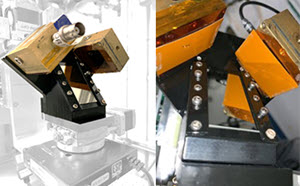
SDRD Highlight: SDRD projects win R&D 100 awards

Many projects the NNSS submits to the prestigious R&D 100 awards get their start as SDRD projects. From feasibility studies to exploratory research, SDRD allows scientists and engineers to engage in cutting-edge research and technology in global security and stockpile stewardship. All five of the NNSS projects that were finalists or winners since 2017 have their roots in SDRD. In fact, our most recent winner, the “X-Ray Polarizing Beam Splitter (XRPBS)” project, began as an SDRD in 2018.

Principal Investigator Radu Presura began the two-year SDRD project “Single-Crystal X-Ray Spectropolarimeter” with researchers from Sandia, Los Alamos, Argonne, and the Special Technologies Lab. This work led to XRPBS, the first X-ray polarizing beam splitter in existence. Using a single cubic crystal, the XRPBS separates an incoming X-ray beam into two linearly polarized beams with mutually orthogonal polarizations, enabling the measurement of both components simultaneously. This technology can be used for plasma diagnostics and analyzing the linear polarization state of an X-ray beam.
The idea was born out of an observation that plasmas could be better characterized if the polarization of emitted X-rays could be measured. There are many exciting opportunities for the XRPBS on multiple testbeds across the National Security Enterprise. One application that Presura plans to explore in the future is to build an interferometer. The goal would be to split the beam using XRPBS, pass the split beam through a material for characterization, use the other beam as a reference, and then recombine the beams for detailed comparative analysis. The research team plans to use the MSTS end station facility at the Stanford Synchrotron Radiation Lightsource (SSRL) for this additional research.

Other NNSS projects that have been recognized in past R&D 100 awards are “The Aerial Reconnoiter Using Unmanned Systems (ICARUS)” in 2020 (finalist), “Falcon Plasma Focus” in 2019 (finalist), “Silicon Strip Cosmic Muon Detector” in 2018 (winner), “Geometrically Enhanced Photocathodes” in 2017 (winner), “Argus Fisheye Probe” in 2015 (finalist), “Nuclear Energy in Space” (the KiloPower project with LANL) in 2013 (winner), “Multiplexed Photonic Doppler Velocimeter (PDV)” in 2012 (winner), “Faster than the Speed of Sound” (the Movies of eXtreme Imaging Experiments (MOXIE) project with LANL) in 2010 (winner), and “In Shocking Conditions, Holograms Come Through” (the High-Resolution UV Holography Lens project) in 2009 (winner).
Of all these innovative projects, six began as SDRDs, making SDRD the largest contributor to R&D 100 success for the NNSS.
